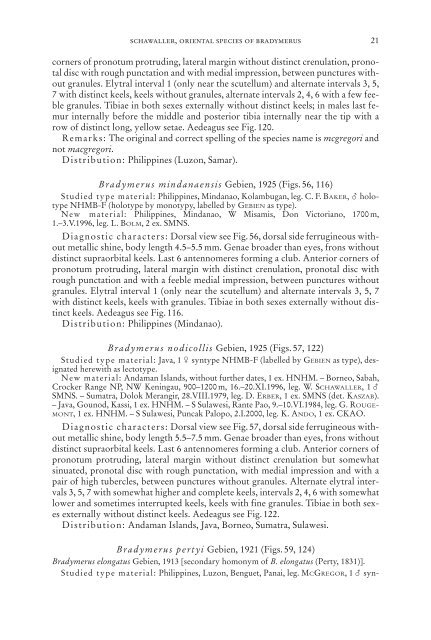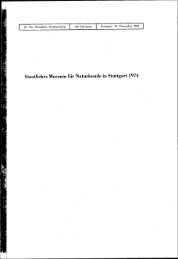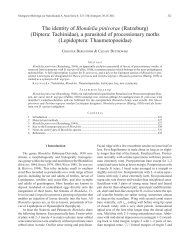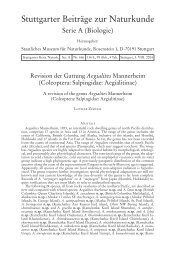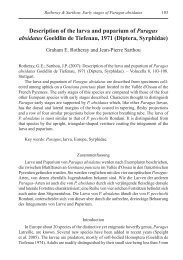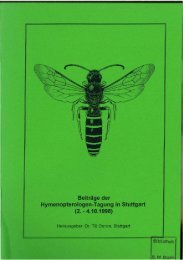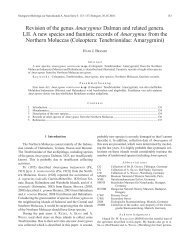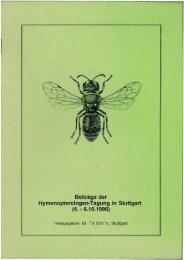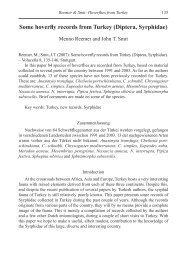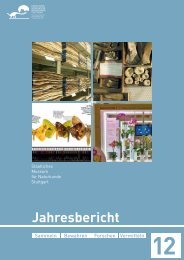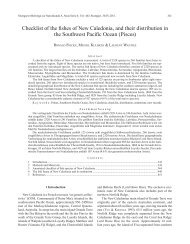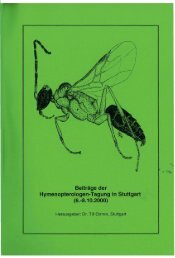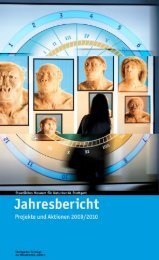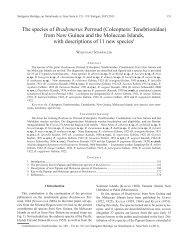Serie A (Biologie) - Staatliches Museum für Naturkunde Stuttgart
Serie A (Biologie) - Staatliches Museum für Naturkunde Stuttgart
Serie A (Biologie) - Staatliches Museum für Naturkunde Stuttgart
Create successful ePaper yourself
Turn your PDF publications into a flip-book with our unique Google optimized e-Paper software.
Bradymerus pertyi Gebien, 1921 (Figs. 59, 124)Bradymerus elongatus Gebien, 1913 [secondary homonym of B. elongatus (Perty, 1831)].Studied type material: Philippines, Luzon, Benguet, Panai, leg. MCGREGOR, 1 synschawaller,oriental species of bradymerus 21corners of pronotum protruding, lateral margin without distinct crenulation, pronotaldisc with rough punctation and with medial impression, between punctures withoutgranules. Elytral interval 1 (only near the scutellum) and alternate intervals 3, 5,7 with distinct keels, keels without granules, alternate intervals 2, 4, 6 with a few feeblegranules. Tibiae in both sexes externally without distinct keels; in males last femurinternally before the middle and posterior tibia internally near the tip with arow of distinct long, yellow setae. Aedeagus see Fig. 120.Remarks: The original and correct spelling of the species name is mcgregori andnot macgregori.Distribution: Philippines (Luzon, Samar).Bradymerus mindanaensis Gebien, 1925 (Figs. 56, 116)Studied type material: Philippines, Mindanao, Kolambugan, leg. C. F. BAKER, holotypeNHMB-F (holotype by monotypy, labelled by GEBIEN as type).New material: Philippines, Mindanao, W Misamis, Don Victoriano, 1700 m,1.–3.V.1996, leg. L. BOLM, 2 ex. SMNS.Diagnostic characters: Dorsal view see Fig. 56, dorsal side ferrugineous withoutmetallic shine, body length 4.5–5.5 mm. Genae broader than eyes, frons withoutdistinct supraorbital keels. Last 6 antennomeres forming a club. Anterior corners ofpronotum protruding, lateral margin with distinct crenulation, pronotal disc withrough punctation and with a feeble medial impression, between punctures withoutgranules. Elytral interval 1 (only near the scutellum) and alternate intervals 3, 5, 7with distinct keels, keels with granules. Tibiae in both sexes externally without distinctkeels. Aedeagus see Fig. 116.Distribution: Philippines (Mindanao).Bradymerus nodicollis Gebien, 1925 (Figs. 57, 122)Studied type material: Java, 1 syntype NHMB-F (labelled by GEBIEN as type), designatedherewith as lectotype.New material: Andaman Islands, without further dates, 1 ex. HNHM. – Borneo, Sabah,Crocker Range NP, NW Keningau, 900–1200 m, 16.–20.XI.1996, leg. W. SCHAWALLER, 1 SMNS. – Sumatra, Dolok Merangir, 28.VIII.1979, leg. D. ERBER, 1 ex. SMNS (det. KASZAB).– Java, Gounod, Kassi, 1 ex. HNHM. – S Sulawesi, Rante Pao, 9.–10.VI.1984, leg. G. ROUGE-MONT, 1 ex. HNHM. – S Sulawesi, Puncak Palopo, 2.I.2000, leg. K. ANDO, 1 ex. CKAO.Diagnostic characters: Dorsal view see Fig. 57, dorsal side ferrugineous withoutmetallic shine, body length 5.5–7.5 mm. Genae broader than eyes, frons withoutdistinct supraorbital keels. Last 6 antennomeres forming a club. Anterior corners ofpronotum protruding, lateral margin without distinct crenulation but somewhatsinuated, pronotal disc with rough punctation, with medial impression and with apair of high tubercles, between punctures without granules. Alternate elytral intervals3, 5, 7 with somewhat higher and complete keels, intervals 2, 4, 6 with somewhatlower and sometimes interrupted keels, keels with fine granules. Tibiae in both sexesexternally without distinct keels. Aedeagus see Fig. 122.Distribution: Andaman Islands, Java, Borneo, Sumatra, Sulawesi.


